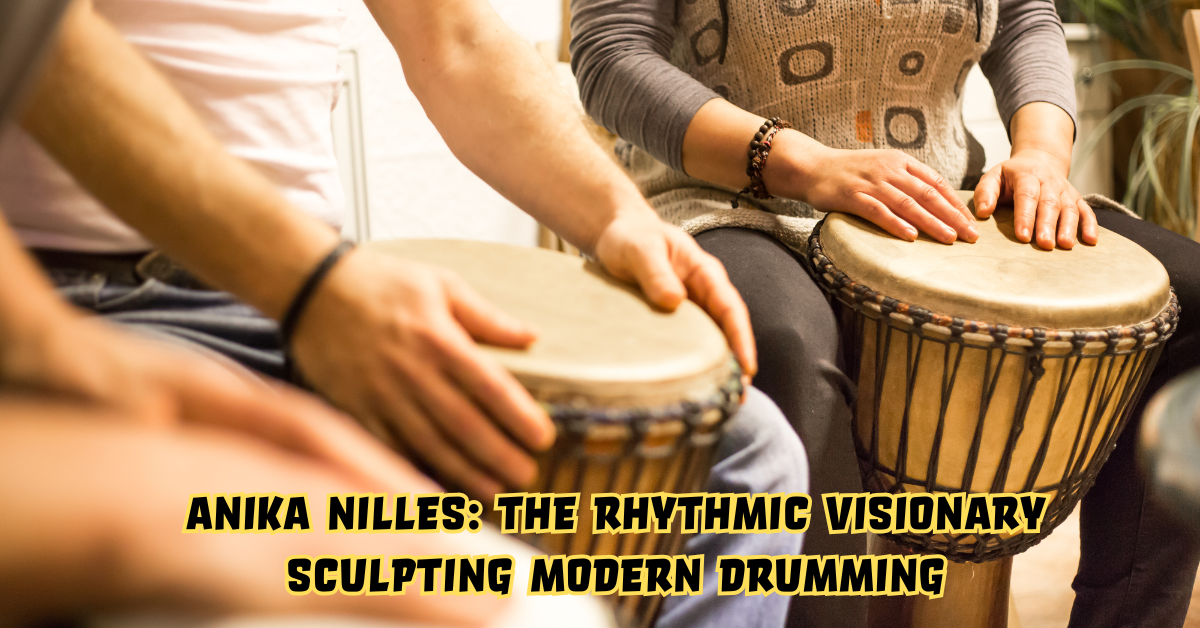Anika Nilles was born and raised in Germany, in a milieu that valued musical exploration. From childhood, she sensed rhythm not just as notes on paper, but as a force that could narrate stories. Her early environment became the crucible for her rhythmic sensibilities: household soundscapes, the turntable hums, the cadence of footsteps in corridors, and the breathing hush between phrases—all conspired to awaken a primordial connection to time. At an age when many children pick up nursery rhymes, she was already internalizing pulse and groove.
As she progressed into adolescence, Nilles pursued formal study in music theory, percussion techniques, and composition. She immersed herself in diverse genres—classical, jazz, fusion, progressive rock—and absorbed influences from drummers across generations. Her formal education laid the foundation for her ultimate signature: the convergence of structure and spontaneity. In those years she began writing rudimentary compositions, attempting to marry melody and rhythm, not merely treat drums as accompaniment.
Her breakthrough realization came when she discerned that drums could speak. They could respond, initiate, converse—not only underpin. That realization shifted her focus: from technical display to narrative through rhythm. She became less a technician and more a storyteller of time.
During her early adult years she participated in local ensembles, teaching small classes, composing short pieces, and experimenting with hybrid time signatures. She would often rehearse with metronomes that changed tempo mid-run, forcing sensitivity to internal pulse rather than strict external references. That skill would later become one of her hallmarks: elastic tempo feeling—the ability to stretch or compress time with feel rather than resort to obvious accelerations or decelerations.
Her early struggles included finding mentors who accepted her rhythmic vision and connecting with other like-minded musicians who would trust her rhythmic leadership. Yet these years fueled her persistence. The seeds of her signature approach—melding groove, nuance, and compositional intention—were sown in these formative struggles and explorations.
Artistic Philosophy: Time as a Living Organism
At the heart of Anika Nilles’s drumming philosophy lies a conviction: time is not rigid, but alive. She argues that treating rhythms with inflexibility—confining them to strict grids—robs music of breathing space. Instead, she cultivates a dynamic relationship with pulse, where slight deviations, micro-shifts, and internal tension yield emotional depth.
In her view, a drummer must listen insideward as much as outward. That means feeling time from the core of one’s body, from heartbeat and breath, then projecting outward into the ensemble. She teaches students to feel subdivisions, to sense implied subdivisions even when not explicitly played, and to play around those subdivisions.
Nilles often frames her work as an interplay between structure and moment: the composition provides a scaffold, but the moment demands responsiveness. She speaks of tension and release not just melodically, but rhythmically, finding ways to stretch phrases, drop micro-silences, or reverse accent lines spontaneously. Rhythm becomes a living dialogue, not a mechanistic backdrop.
She also emphasizes storytelling through dynamics in time. A fill is not merely a technical flourish; it is a punctuation mark, a shift in narrative. A ghost stroke or a subtle sticking variation is like a whisper or inflection in speech. In her masterclasses, she challenges drummers to map out the narrative arc of a piece—from introduction through climax to resolution—then align each rhythmic gesture with that arc.
In her workshops she often quotes (paraphrased): “Rhythm is a language; every beat must speak.” She encourages students to think of drumming as speaking through silence and sound, not just filling space.
Signature Style: Techniques, Compositions, and Innovations
What makes Anika Nilles’s drumming instantly recognizable is the alchemy of technique, character, and compositional intention. Her signature style is not about maximum speed or complexity, but about purposeful nuance.
One distinctive trait is her use of poly-metric figures: she often superimposes patterns of different subdivisions over a base pulse, creating tension and layering without sacrificing groove. For instance, she might play a 5-over-4 pattern in the hi-hat against a 4/4 snare-kick framework, with subtle accents that resolve at phrase markers. These patterns feel natural, not forced.
Another hallmark: dynamic ghost note control. She employs ghost strokes at ultra-low volume to fill space like shadows, painting texture beneath main strokes. These ghost strokes shift subtly in velocity, offering micro-phrasing inside groove.
Further, her sticking vocabulary is exceptionally fluid. She often uses unconventional sticking: right-left switches, Swiss rudiments, varying stick heights, crossovers, and accents from alternate hands to create expressive lines. But she always remains grounded: these are not tricks, but tools.
Her compositions frequently incorporate metric modulation—a transition where a rhythm in one subdivision becomes the reference for a new pulse. She uses these modulations to pivot sections without abruptness, to spin groove into new territory. Her pieces also often contain odd-meter bridges, interlaced with more accessible 4/4 segments.
Importantly, she tailors her approach to instrumentation: on a kit, she may use multi-tom motifs, melodic tom voice leading, or sympathetic tones; with electronic pads, she might trigger loops or textures that interplay with her acoustic kit. She blends acoustic and electronic devices, affinities that allow her to expand her palette.
Yet, technical brilliance is never the end goal; emotional connection is. Listeners often describe her drumming as conversational, empathetic, unforced. She plays with time rather than against it.
Career Highlights and Collaborations
Anika Nilles’s rise has been marked by a blend of independent projects, clinic tours, online influence, and collaborative work.
Her solo album release (self-produced) showcased her compositional depth. It presented compositions that weren’t built around individual solos but around rhythmic narratives—grooves, motifs, and dynamic arcs. The record gained recognition in drumming and progressive music circles. Her tracks reveal not just drums, but melodic movement, phrasing, and structure.
She has also ventured into clinics and masterclasses worldwide, teaching her approach to drummers of varied levels. Through these events, she spreads her rhythmic philosophy and inspires others. Her teaching videos and online courses have expanded her reach beyond immediate concerts.
Collaboratively, she has worked with musicians across genres—fusion projects, progressive rock bands, jazz ensembles, and pop artists. Her adaptability allows her to shift between supporting role and leading rhythmic voice. She has contributed drum parts to composition projects, helped shape arrangements, and occasionally co-composed with other artists.
At times she has been guest for high-profile drum festivals, judged competitions, and performed in drum-centric showcases. These engagements further cement her reputation as both performer and pedagogical influencer.
One often-quoted idea from her: “Play less, say more.” She embodies that in her collaborations—rarely does she overplay; she chooses where to speak and when to listen. That maturity is one reason her engagements with other artists often feel symbiotic rather than competitive.
Behind the Scenes: Practice, Tools, and Workflow
What does Anika Nilles’s daily or weekly practice look like? How does she prepare for a composition or performance? What gear does she favor? The behind-the-scenes habits illuminate how she sustains her artistry.
Practice and Internalization
Her practice is not just scale runs or rudiment drills; it’s contextual. She focuses on phrasing, exercises in small musical cells, tempo modulation, ghost-naming subdivisions, odd-meter phrasing, and internal count. Rather than aimless repetition, each exercise is tied to musical goals. She may pick a four-bar groove and slowly rework it, varying accents, subdividing, altering feel, or shifting meter.
She gives importance to silence and microrests. She practices stopping mid-phrase to re-enter seamlessly. She explores how absence of sound can frame what comes after.
She includes listening exercise sessions, where she drums along with non-drum music—classical, vocals, ambient—to better attune to musical context, rather than focus only on drums.
Tools and Equipment
While she evolves over time, she generally selects gear that provides nuance and clarity: responsive snare heads, refined cymbals, well-tuned drums. She often combines acoustic drums with electronic pads or triggers, using them to layer textures or orchestrate transitions. Her cymbal selection tends toward ones with clear bell voices and controlled wash.
Her microphones, mixing choices, and setup in live contexts also favor capturing ghost strokes and dynamic gradations more than sheer volume. She works closely with sound engineers to preserve articulation.
Composition Workflow
Her composition often begins rhythmically: she might start with a rudimental motif or a signature rhythmic cell. Over that skeleton, she layers melodic or harmonic ideas (either via keyboard, guitar, or collaborating musicians). She might record drum sketches to internalize feel before fleshing out full version. She iterates: record, listen, adjust microphrasing, refine internal accents. The drum part is not an afterthought, but central to the architecture.
She frequently maps transitions via metric modulation planning, marking pivot bars where one subdivision becomes reference for next. She rehearses transitions at slow tempos until they feel seamless. In her view, transitions are more critical than main groove—they shape listener perception.
Impact and Influence on Contemporary Drumming
Anika Nilles’s influence spreads across multiple dimensions: pedagogical, stylistic, gender representation, and modern drumming aesthetics.
Pedagogical Influence
Her masterclasses, videos, and teaching materials reach drummers globally. Some of her innovations—elastic tempo feel, subtle ghost-note phrasing, metric modulation in compositions—have filtered into curricula at drum schools. Young drummers often cite her as a source of inspiration not for sheer technical display, but for a deeper rhythmic sensibility. Her approach invites drummers to move beyond technical flexing into narrative rhythm.
Stylistic Trends
Because Nilles demonstrates that complexity can remain musical and that groove and nuance need not be mutually exclusive, many drummers adopt her preference for less-is-more when strategic. Her signature rhythmic vocabulary — shifting subdivisions, ghost textures, polyrhythms with feel — appears in modern progressive and fusion drummers who wish to combine technical depth with listener accessibility.
Representation and Role Modeling
As a prominent female drummer in a historically male-dominated domain, she contributes importantly to diversity in drumming. Her visibility—performances, interviews, presence on social media and clinics—offers a tangible role model for young women pursuing percussion. She breaks stereotypes by defying the notion that virtuosity and sensitivity are mutually exclusive in a female drummer.
Evolving Aesthetic of Drumming
In a musical landscape where many drummers compete for maximum speed or effect, Nilles suggests an alternative path: rhythmic intelligence, tasteful restraint, and narrative conception. She helps shift perceptions: virtuosity need not be measured in strokes-per-minute but in emotional depth, velocity control, and musical conversation. Her influence nudges the drumming community toward more thoughtful, listener-conscious performance.
Comparative Overview: Techniques and Influences
To situate Anika Nilles in the broader drumming world, we compare key attributes across a few exemplar drummers and techniques.
| Drummer / Approach | Emphasis / Signature | Contrast with Nilles |
|---|---|---|
| Buddy Rich / Neil Peart | Speed, powerhouse fills, showmanship | Nilles opts for narrative nuance over sheer speed |
| Vinnie Colaiuta | Versatility, odd meter, fusion chops | Nilles shares meter fluency but foregrounds ghost dynamics |
| Jojo Mayer / Mark Guiliana | Electronic-acoustic hybrid, groove experiments | Nilles similarly bridges electronics but with more melodic phrasing |
| Steve Gadd / Matt Garstka | Subtle pocket groove, texture, phrasing | Nilles combines both texture and forward motion sensitivity |
| Technique / Concept | Definition in Nilles’s Context | Application & Significance |
|---|---|---|
| Metric Modulation | Pivoting subdivisions become new pulse | Enables seamless transitions without jarring shifts |
| Ghost Notes & Micro-Ghosting | Ultra soft strokes filling space | Adds texture, inner voices within groove |
| Elastic Tempo | Micro-accelerations / decelerations | Emotional phrasing and breathing in time |
| Polyrhythmic Interplay | Superimposing alternate subdivisions | Creates rhythmic depth while preserving groove |
These tables help clarify how Nilles’s methods relate to, diverge from, or extend rhythmic practices across the drumming spectrum.
Repertoire and Notable Works
Anika Nilles’s recorded pieces offer windows into her creative mind—each composition is a miniature rhythmic world. While she may have dozens of compositions, a few stand out for their structural complexity, emotional sweep, and rhythmic lessons.
One featured piece begins with a minimalistic 4/4 groove, gradually introducing ghost-note patterns and metric modulation to 7/8, then pivoting to 5/4 before returning to a transformed 4/4. The listener may sense transition as organic, not abrupt, because she carefully plotted subdivisions and phasing lines. The track’s narrative arc follows a tension-rise-release shape.
Another composition uses an ostinato in the toms and shift patterns in the hi-hat, weaving interplay between melody and rhythm. It uses silence as much as sound, with micro-rests that give phrases space to breathe. The drum voice sometimes converses with the bass or guitar lines, not simply underpin them.
In her solo drum performance videos, she sometimes splits kits or uses multi-percussion systems, shifting from drum kit to floor percussion, or integrating trigger pads. She treats the kit as not just a rhythm machine but as an ensemble in miniature: toms speak, cymbals respond, snare pulses, and triggers add color.
Her live renditions often vary from studio versions, because she embraces improvisation respecting compositional constraints. She may stretch transitions, drop in extra ghost-note phrases, or insert micro-fills mid-phrase. These live differences underscore her view of rhythm as living.
Challenges, Misconceptions, and Evolution
No artist evolves without missteps, misconceptions, or recalibrations. Anika Nilles’s journey is shaped by both internal critique and external reception.
One challenge has been audience expectations. Some listeners expect drummers to produce fireworks; when she plays with restraint or emphasis on texture, some misunderstand it as less impressive. She addresses this by inviting active listening and educational outreach—guiding audiences to hear nuance.
Another misconception: that her style is only for “progressive drumming nerds.” In reality, her rhythmic ideas can translate into broader musical contexts—pop, singer-songwriter, film scoring—if adapted thoughtfully. She often gets asked: “can your techniques apply to simpler grooves?” Her answer: yes—ghosts, phrasing, micro-touch, internal tension exist in all music.
She also faced the technical evolution demands. As compositions and collaborations require evolving setups, she must adapt gear, sound, workflow. Staying comfortable with constant change is a personal challenge, but she embraces it as part of growth.
Internally, she battles perfectionism and overthinking, like many creative minds. Some recorded takes she discards not because technically flawed, but because they lack emotional resonance. She sometimes meditates or takes rhythmic walks to reset perspective when stuck.
Over time, her style evolved: early work more display-oriented, later works more atmospheric and composed. She now values restraint even more—holding back becomes a deliberate choice. That evolution signals maturity: knowing when not to play is as critical as knowing when to play.
How to Study Her Style: Pathways for Drummers
For drummers seeking to learn from Anika Nilles—without imitating, but assimilating principles—here is a progressive roadmap:
- Develop internal subdivision awareness
Practice feeling subdivisions (eighths, sixteenths, triplets) without metronome, then overlay metronome. Work on counting inside micro-pulses. - Ghost strokes and dynamics mastery
Isolate a groove, remove one hand, practice ghost strokes of varying velocity. Focus on uniformity, gradation, and how micro-variance changes feel. - Polyrhythm experiments
Superimpose 3:2, 5:4, 7:4 patterns over base groove. Use accent shifts to resolve alignment points. Start slow, gradually increase speed. - Metric modulation exercises
Take a simple rhythmic cell. Determine a division as a new pulse—execute slow tempo change pivoting around that shared subdivision. - Micro-rests and silence practice
Insert single-beat or half-beat rests inside grooves and resolve back. Practice dropping out and re-entering mid-phrase. - Compose short drum-based sketches
Write 8-bar or 16-bar sketches to explore phrasing, transitions, and minimalism. Use those as basis to expand into full pieces. - Transcribe her performances
Carefully listen to her videos. Not for mimicry, but to see how she applies those techniques in context. Observe transitions, micro-tempo shifts, ghost trails. - Apply to musical contexts
Take non-drum songs (pop, folk, ambient) and re-drum them using her vocabulary. Use ghost strokes, phrasing, micro-rests to transform simple grooves.
By walking gradually through these stages, a drummer internalizes the principles rather than copying licks. The goal is expressive rhythmic intelligence, not reproduction.
Live Performance and Audience Reception
Anika Nilles’s live performances are not just displays of technique—they are immersive rhythmic dialogues with the audience. Her approach to stage presence and set design reflects her philosophy: space, contrast, and narrative.
On stage, she often begins in sparse setup—focusing initially on minimalist grooves, then building textures, layering ghost strokes, triggering ambient pads, and gradually unveiling the full rhythmic canvas. That slow revelation invites the audience to absorb each layer, not be overwhelmed early.
She sometimes incorporates short “drum solos,” but these are shaped rather than free-for-all: transitions, motifs, call-and-response segments with other musicians, and dynamic arcs. She ensures these solos contribute to the set’s narrative, not act as standalone spectacle.
Audience reactions often note a shift: what begins as attention on her hands and feet becomes immersive listening to time itself. Many attendees comment, “I felt the space between the beats,” or “the silent moments resonated more than fills.” That kind of feedback reflects her success.
Critics often commend the balance in her concerts: virtuosity without ostentation, groove without monotony, surprises without confinement. Her live presence demonstrates that artistry can arise from nuance.
Challenges in Monetization and Recognition
Even for a musician of her standing, the path of balancing art and livelihood presents complications. Unlike mainstream pop drummers embedded in superstar acts, Nilles has to navigate how to monetize her artistry without compromising integrity.
She generates revenue through multiple streams: album sales (digital/physical), online lesson platforms, clinic appearances, merchandise, session work, and licensing. But each stream demands attention beyond artistry—marketing, scheduling, logistics, travel. Balancing those responsibilities with creative time is a perennial tension.
Recognition via awards, large mainstream media, or commercial charting is less predictable for rhythmic composers. Drummers rarely headline at the level of singers or front-line instrumentalists. Thus, building name recognition requires persistent engagement—social media, interviews, features in drumming magazines, and maintaining visibility. She must self-advocate without overexposure.
Moreover, global touring demands logistical and financial risk. Transporting gear, coordinating sound engineers who can render her subtle dynamic gestures, and building audiences in new territories require careful planning. In less drum-centric markets, her niche style may demand educational outreach for audiences new to attentive rhythmic listening.
Still, many drummers in her network view her as a model: by combining music, teaching, touring, and building relationships, she sustains a career not dependent on backing a superstar—but built on integrity and rhythmic innovation.
Future Trajectories and Legacy
What does the future hold for Anika Nilles—as an artist, leader, and influencer? Based on her trajectory and her philosophical compass, several directions seem plausible.
She may expand further into composition beyond drums—writing ensemble works, film or media scoring, or collaborating on orchestral-percussion hybrids. Her rhythmic sensibility would enrich broader musical formats.
She might deepen her pedagogical offerings: immersive rhythm academies, global masterclass residencies, virtual reality drumming curricula, or interactive AI-based rhythmic coaching tools. Her commitment to sharing time-feel could scale into new educational technologies.
She may partner with instrument makers to design signature gear—snares, cymbals, drumheads tuned for nuance, with responsiveness attuned to ghost dynamics. That would further extend her voice into instrument design.
As her influence proliferates, she may become a key link in a new generation of drummers who prioritize narrative over display, touch over volume, and conversation over soloing. Her legacy might be measured not only in accolades but in how many drummers adopt and reinterpret her concepts.
In fifty years, her influence might echo in genres we do not yet anticipate, as her core idea—that rhythm is alive—gets woven into new musical languages.
FAQs on Anika Nilles
1. What makes Anika Nilles’s drumming style unique?
Her style is unique for combining narrative rhythmic phrasing, ghost-note control, metric modulation, and elastic tempo feel rather than sheer speed or volume. She treats drums as a speaking instrument, not just a timekeeper.
2. Can her techniques be applied to simple musical genres?
Yes. Her techniques—ghost notes, micro-rests, phrasing, internal subdivision awareness—can enrich rock, pop, folk, or any genre. The adaptation lies in tasteful moderation, not heavy-handedness.
3. How can a drummer start studying in her style?
Begin with internal counting and subdivisions, practice ghost strokes, explore polyrhythms, compose short rhythmic sketches, transcribe her work, and gradually apply her principles to real musical contexts.
4. What gear does she prefer?
She favors responsive snare and cymbals, electronics integrated with acoustic drums, triggers or pads, and setups that preserve subtle dynamics. Her gear choice is designed to allow nuance rather than brute force.
5. How does she balance creativity and business?
Through diversified revenue—albums, teaching, clinics, session work—and persistent self-promotion. She negotiates touring logistics, marketing, and creative time carefully to avoid burnout while sustaining her artistic integrity.
Conclusion
Anika Nilles is not just a drummer; she is a rhythmic philosopher sculpting time with sensitivity, intention, and narrative. From her early years absorbing pulse to her mature compositions that weave metric modulation and ghost strokes into musical arcs, she challenges the drumming world to rethink what a drummer can be. Her philosophy—that rhythm lives and breathes, that silence is as meaningful as sound—offers a compelling alternative to flash-based virtuosity.
Her career embodies multiplicity: performer, composer, teacher, collaborator, and influencer. Her influence ripples into pedagogy, stylistic trends, and representation. For drummers and music lovers alike, her work invites deeper listening—beyond fills and flams—to the inner architecture of musical time.
As you consider exploring her music, transcribing her compositions, practicing her methods, or attending her clinics, remember: the aim is not replication, but internalization of principles. Let your own rhythmic voice emerge, enriched by her insights. In doing so, you carry forward one of the most compelling contributions to modern drumming: that time need not be kept—it can be played.











